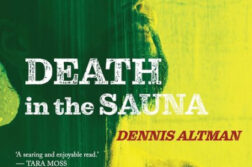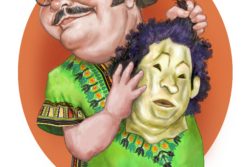I WROTE Homosexual: Oppression and Liberation after six months of living in New York City over the winter of 1970–71, when I was lucky enough to become part of the emerging gay liberation movement, and to work for a time on the newspaper Come Out! Thanks to a lukewarm review in Time magazine, and a more enthusiastic one by Martin Duberman in The New York Times, the book survived its first publication by an obscure publisher to become a mass market paperback and subsequently to be translated into several languages. The book was reissued in 1993 by New York University Press, with a forward by my British colleague and friend, Jeffrey Weeks, and is coming out later in this year in a Japanese edition, published by Iwanami Shoten.
Homosexual was written in a particular historical moment, when the gay liberation movement in a few Western countries emerged from the radical mix of politics, culture, and lifestyles of the early 1970’s. Like other movements of its time, it soon would change, and the movement that existed ten years later seemed far more staid, limited in its aims—and successful. (I wrote at length of these changes during the 1970’s in my book The Homosexualization of America.) At that point it seemed as if homosexuality would gradually become an accepted basis for identity politics and communal organization, at least in those countries with strong liberal and secular traditions. Both the radical rhetoric of gay liberation and the extreme stigma and social disapproval against which we fought seemed to be vanishing faster than anyone had foreseen in the halcyon days of gay radicalism. The modern gay movement is dominated by its American history and its roots in American cultural politics. This dominance has led to an almost deliberate forgetting of history, of the origins of homosexual organizing in post-World War I Germany, and its subsequent emergence in some other countries of Western Europe. The myth of Stonewall means that too many people forget the early gay movements in France, the Netherlands, and Switzerland. The emergence of a radical gay activism in the 1968 events in France and Italy, which preceded the Stonewall Riots in New York by a year, is generally assumed to be the trigger for homosexual movements worldwide.
The intellectual origins of gay liberation resided in a heady amalgam of countercultural and radical ideas derived from Freud and Marx. Thus it was something of a shock to encounter criticisms from younger queer academics in the 1990’s that it was an essentialist movement, reinforcing conventional assumptions of a fixed sexuality. Most of the early gay liberationists, at least in North America, had not read Freud or Marx, let alone their most radical interpreters, such as Herbert Marcuse and Wilhelm Reich, but they did champion ideas of sexual fluidity and experimentation. By the early 1970’s, gay liberation groups had largely collapsed, replaced by new organizations such as the National Gay Task Force. As the mainstream movement began to develop a model of identity politics based on analogies with ethnic groups, it became attracted to biological ideas about the fixed and immutable nature of sexual attraction. It also moved away from the assumptions of gay liberation, developing instead an ever-growing list of sexual identities, assumed to be the basis for political and social community. Thus “bisexuality” became a new political identity, rather than, as gay liberationists had believed, a normal human ability to find sexual attraction in other humans irrespective of gender.
The onset of AIDS could have changed this trajectory. Although its origins were elsewhere, American medical supremacy meant it was only defined and named once it appeared among healthy young gay men on the two coasts; indeed for about a year in the early 1980’s it was known as Gay-Related Immune Deficiency or GRID, until it became clear that anal intercourse was far from the only effective means of its spread. The early reactions to AIDS did reinforce certain sorts of homophobia (as well as anti-Americanism, particularly in certain countries of Asia). But AIDS also created unparalleled organizing and communal responses among people now calling themselves gay and lesbian, and the gay communities of the Western world pioneered a whole set of responses to HIV and AIDS, such as safer sex, peer education, and volunteer “buddies,” that would influence the larger social responses to the new epidemic. The need to develop effective prevention programs against HIV also meant that a number of Western governments started supporting and funding new gay groups in parts of the world where the very concept was alien, thus justifying in one sense the accusation that sexual identity politics was indeed an expression of Western influence.
AIDS also radicalized many gay men and led to an interrogation into the ways in which the gay movement may have been co-opted by easy and partial victories. Anger at the sight of so many young men dying with so little public concern generated a new activism, above all in the U.S., and with it a rebirth of interest in radical sexual politics and its academic expression in “queer theory.” Indeed, from its inception in the literary and philosophical writings of people like Eve Sedgwick and Judith Butler in the early 1990’s, queer theory was a strange mix of radical anger and rarefied intellectualism. I once referred to queer theory as “the bastard child of the gay and lesbian movement and postmodern literary theory, which like other unwed mothers has been very loath to acknowledge the father.”* Too many queer theorists seemed unaware of the extent to which their claims were a restatement, often in more elaborate and sophisticated form, of the earlier claims of gay liberation.
In the new century, the attention of gays and lesbians in Western countries, again most clearly in the U.S., seems to have returned to demands for equality based not on questioning mainstream norms and dichotomies, but rather on demanding inclusion in the status quo. Gay marriage and the right to serve in the military seem the major issues for a new generation of activists, who combine a radical assertion of their sexuality with demands for inclusion within conventional frameworks. Gay and lesbian characters erupt across mainstream television programs, but they’re portrayed as if they belonged to a clearly defined racial or ethnic group. Thus, for example, in the TV series Desperate Housewives, the African-American family in one season was replaced by a gay couple in the next. The reality show Queer Eye for the Straight Guy was premised on there being an indelible line between “gay” (sophisticated but weird) and “straight” (nerdy but normal), one that never allowed for sexual attraction, much less activity, across this barrier.
Queer theory still thrives in American universities, kept alive by a small band of journals, but it is no longer at the cutting edge of thinking about sex and gender. Indeed it’s remarkable how little impact queer theory has had on international understandings and discourses around hiv/aids. While some of the most interesting American writing on responses to the epidemic have clearly been influenced by queer theory, this connection seems to disappear once one moves to other parts of the world. This is not surprising: for most activists, particularly in Asia and Africa, just establishing the existence of homosexual behavior—and breaking down the enormous stigma and ignorance that surround it—has been a major battle.
In the richer countries of Asia, such as Japan, South Korea, and Singapore, there has been a real reluctance on the part of governments and the media to acknowledge the extent to which the growth of HIV is concentrated among homosexual men, and to provide adequate resources for prevention education. Interestingly, there are signs that governments in India and China are now recognizing the existence of homosexual populations and the importance of creating targeted HIV-prevention programs that might address their needs.
As activists across the world have sought to chart and defend the homosexual worlds that exist, often with complex expressions of sexuality that combine elements of the traditional and the modern, there is emerging a new analysis that might create a more genuinely global form of gay liberation. Consider, for example, the role played by transgendered men in so many Asian societies, and the differing ways in which kathoeys in Thailand, waria in Indonesia, and fafafine in Samoa are incorporated into assumptions about sexuality where these identities are simultaneously seen as products of traditional culture and as threats to traditional morality. Perhaps the most extensive debate about appropriate terminologies and self-perceptions has come from India, where there is now a thriving movement among people who sometimes call themselves gay, lesbian, and transgendered, and who sometimes bitterly reject such terms as foreign importations.
In the contemporary world, a reminder that sexuality and gender are interrelated, complex, and fluid is most likely to come from activists and researchers working in non-Western societies who are trying to find new ways to reconcile traditional and modern patterns of behavior and morality. One of the puzzles of the contemporary world is the violent homophobia, usually sanctified by religion, that exists in countries which have rich traditions of homoeroticism. A major example is Iran, but there are many others. In south Asia, in Malaysia, Singapore, and the East Indies, British laws against sodomy are justified by appeals to tradition, in apparent ignorance that these laws were in fact a product of colonial lawmakers. Many African leaders deny that homosexuality exists within their countries and resort to harsh measures against their citizens who obviously aren’t cognizant of this fact.
Awareness of these paradoxes has been enormously increased through AIDS activism, and over the past few years there has been a remarkable surge of organizing among men who have sex with men in most parts of the world. Gay and lesbian film festivals, street carnivals, pride marches, even political candidates, are now found in most countries where there is political space for them. The Western gay movement likes to talk of the bravery of those who come out, even when they do so in an environment that’s more likely to reward than to punish frankness. Over the past decade, I’ve met many people from south Asia, Africa, and the West Indies where a declaration of homosexuality means not only estrangement from one’s family and possible loss of one’s job, but may also bring threats of imprisonment, torture, and death.
I have also visited Japan several times and know several Japanese involved in gay politics. It’s difficult for foreigners to understand the particular ways in which homosexuality is both taken for granted and denied in Japanese society. Traveling in Japan reminds us that even when the visible signs associated with Western forms of gayness are strong, as they are in some urban areas such as Shinjuku in Tokyo, the ways in which people understand them, and imagine themselves, are rather different. As a rich country without strong religious traditions of homophobia or hostility to gayness as a sign of modernity, Japan might be expected to have produced a larger and more visible gay movement. That it hasn’t suggests that the assumptions of universality, which are implicit throughout the rather unreflective optimism of Homosexual, need to be rethought by a new set of theorists writing from the non-Western world.
Gradually some Western countries, led by the European Union, have begun to place persecution on the basis of sexuality on the human rights agenda. An attempt by Brazil several years ago to introduce a resolution on sexual orientation in the United Nations Human Rights Committee was stymied by a coalition of Islamic and African countries, working closely with the Vatican and the United States.
Dennis Altman’s other books include The Homosexualization of America (1982) and Global Sex (2001); he is a professor of politics at La Trobe University in Australia. This essay is adapted from the introduction to a new Japanese translation of the book.
[/groups_member]




